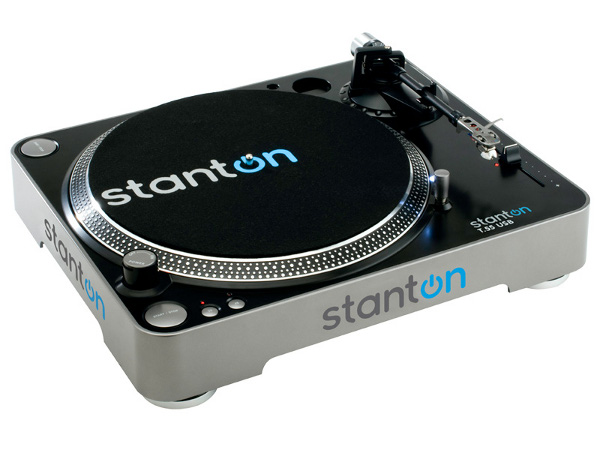
It’s been a long, long time since I’ve looked at turntables, so I rather expected a new one to have fancy features. The Stanton T.55 USB turntable is a no-frills turntable. Aside from the USB port, there’s little obvious difference between this turntable and the ancient cabinet turntable I inherited from my grandmother.
Overview: The Stanton T.55 USB turntable has an on/off switch, two start/stop switches for the platter, buttons to select 33 or 45 rotations per minute, and a cute little LED light. The Stanton also has a slider bar next to the needle arm which you can use to fine-tune to rotation speed of the platter, in case you need to manually adjust the palyback of your records. I didn’t find a need to do this with any of the records I used to test, but that may be my own ignorance as much as anything else. Also included in the package is a spoke to insert into 45 RPM discs, should you need it.
The outputs on the back of the unit consist of the titular USB jack, and stereo RCA jacks. Also on the back are two toggle switches; one for phono or line level output, and one for USB+vinyl or USB only output. The latter is used for “bypassing the phono preamp from the turntable when using for DVS applications.”
The T.55 is shipped mostly unassembled, so it was an illuminating experience to put the drive belt on. It was also illuminating to read the instruction manual on proper tonearm adjustment. None of the record players I had used in the past had any kind of manual adjustment for tone arm angle or pressure — of if they did, I never realized it — so it was interesting to adjust the counterweight on the back of the needle arm to get the pressure just right. Thankfully, the T.55 included a Stanton 500 V3 cartridge for the needle, so I didn’t need to twiddle the angle of the needle at all.
Overall, I was impressed with the construction of the unit. It’s solid, and has a good heft to it, for such a simple device. It looks nice, and ought to look good sitting next to any other home stereo equipment.
The manual has about 4 pages of information on the hardware, and then spends the rest of the document introducing software. I was surprised that Audacity is discussed in some depth, since it’s neither included with the product, nor officially supported by Stanton in any meaningful way. Nonetheless, the manual describes how to download and use Audacity to record MP3s from the turntable! Hooray for free software. Included on a CD, and described in the manual, is Cakewalk Pyro Audio Creator LE. I didn’t use this. I figure it doesn’t much matter what software you use to acquire and manipulate audio input from the T.55: if you don’t like the bundled software, you can find and use something else. I used Audacity to record a couple of discs, and it worked just fine.
Before I ripped any discs, though, I first connected the T.55 to my home stereo. I rocked out to the Jimi Hendrix Experience disc I “borrowed” from my old man all those years ago. It sounded just like I would have expected from a record, and I enjoyed listening to it. Next I hooked it up to my laptop and recorded one side of the disc. I played it back within Audacity, and was mildly annoyed. I guess I’ve become so used to CD quality audio coming out of my laptop’s speakers that the analog artifacts of the record seemed extra jarring. That’s funny, isn’t it? When I played the same record directly through my stereo the pops and hisses were perfectly acceptable, but when coming from my laptop’s speakers is was completely unacceptable.
I recorded a few more discs I had squirreled away, including several Disneyland Records like The Hobbit and The Black Hole. What a trip down memory lane that was! I found several other records I listened to as a kid, like Free To Be… You and Me. Here’s the opening of the baby sequence, which I’ve always enjoyed: Free to be … You and Me: babies
My parents left a surprising amount of vinyl, most of which is European folk dance music. I selected a record full of great polka songs to test out the noise removal function of Audacity to try to eliminate some of the pops and hisses. I think the end result is a little muted in comparison to the original recording, but I must admit I didn’t try too hard. After all, I’m reviewing the hardware, not the Audacity software.
Here’s a segment of the Little Brown Jug Polka as recorded by Audacity. The only effect I applied was “Normalize” in order to make it a little bit louder. Then, using that normalized clip, I took a noise profile using the Noise Removal tool, and finally executed a Noise Removal operation using said profile. Here’s corrected sample of the Little Brown Jug Polka. It doesn’t sound bad, but it could probably use a little more fine tuning to make it sound better. Like I said, I used Audacity’s defaults and spent zero time on this.
Bottom Line: The Stanton T.55 is a good turntable. It plays records, and allows you to record them. It has a very specific feature set, and executes these features well.